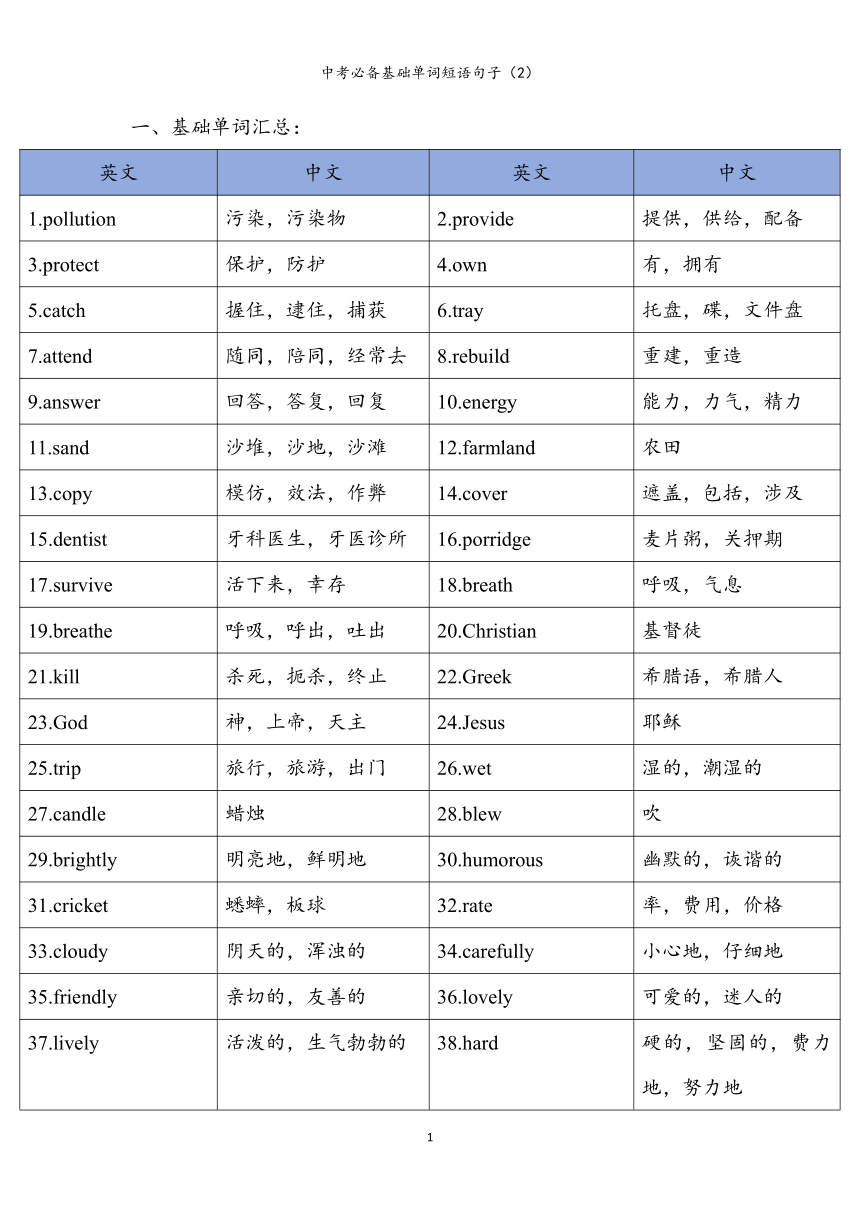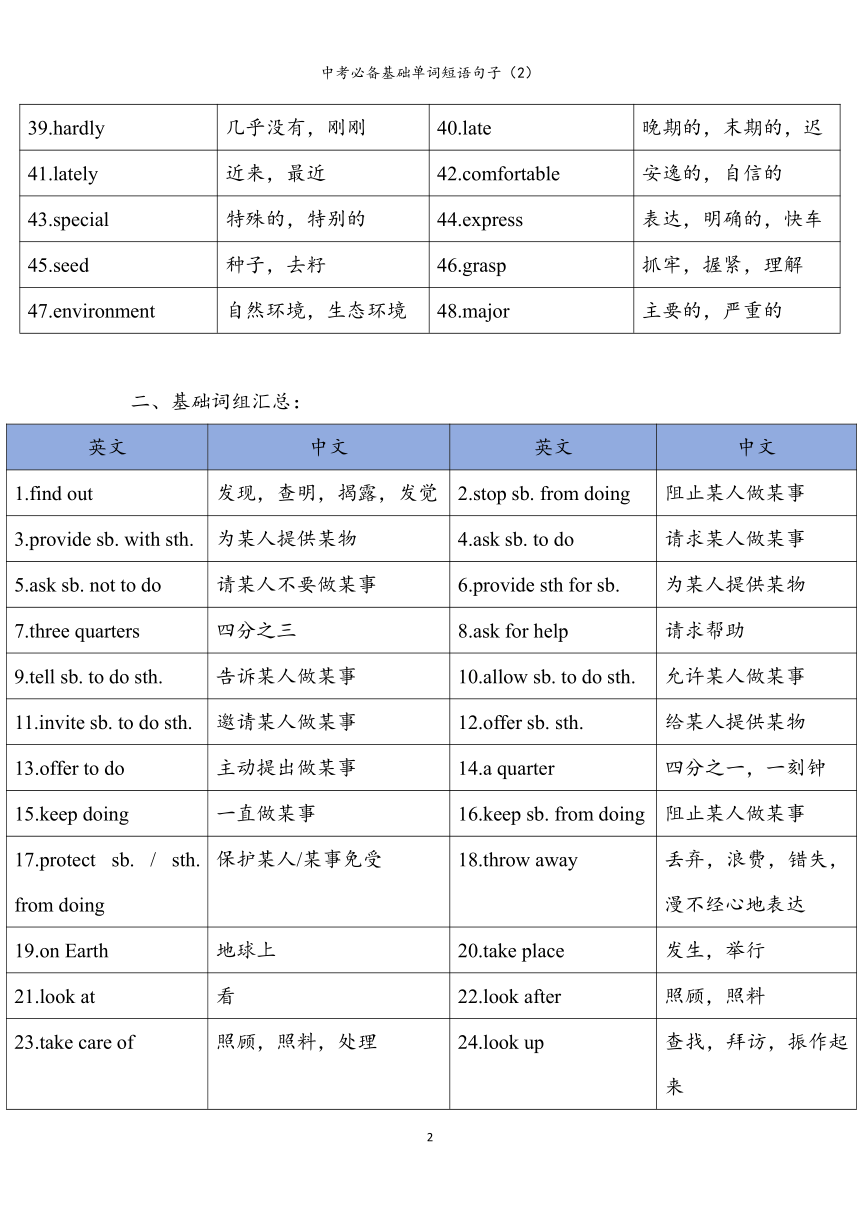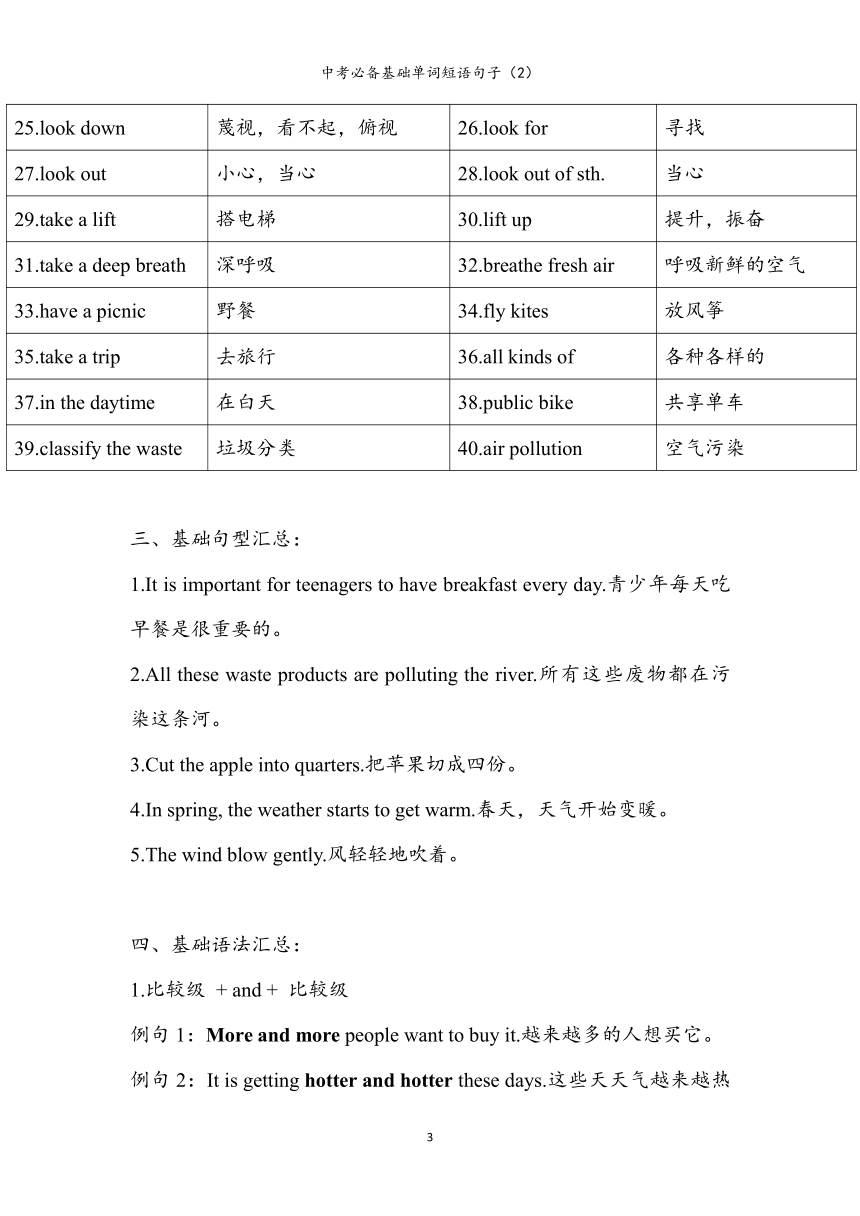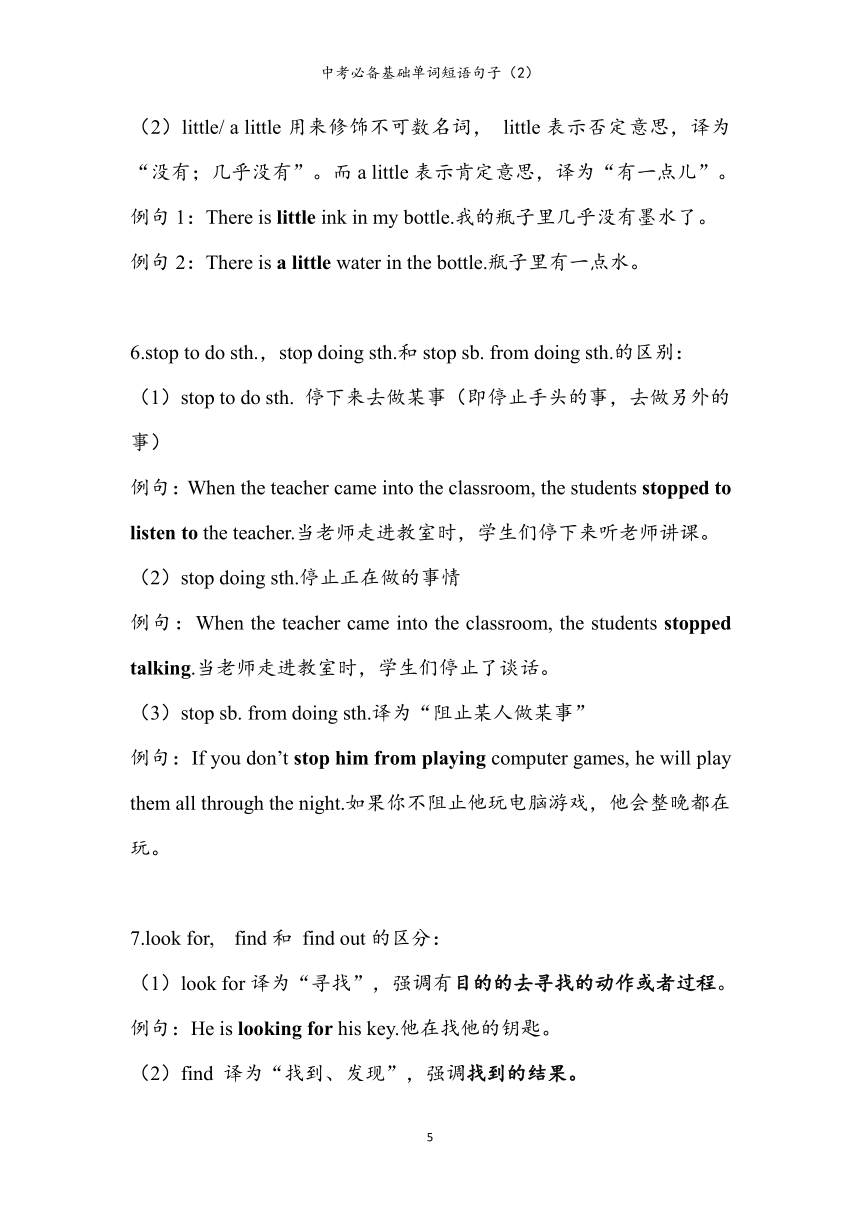沪教牛津版中考英语必备基础单词短语句子+语法(2)
文档属性
| 名称 | 沪教牛津版中考英语必备基础单词短语句子+语法(2) |  | |
| 格式 | docx | ||
| 文件大小 | 45.2KB | ||
| 资源类型 | 试卷 | ||
| 版本资源 | 沪教版 | ||
| 科目 | 英语 | ||
| 更新时间 | 2025-03-18 17:06:18 | ||
图片预览





文档简介
中考必备基础单词短语句子(2)
基础单词汇总:
英文 中文 英文 中文
1.pollution 污染,污染物 2.provide 提供,供给,配备
3.protect 保护,防护 4.own 有,拥有
5.catch 握住,逮住,捕获 6.tray 托盘,碟,文件盘
7.attend 随同,陪同,经常去 8.rebuild 重建,重造
9.answer 回答,答复,回复 10.energy 能力,力气,精力
11.sand 沙堆,沙地,沙滩 12.farmland 农田
13.copy 模仿,效法,作弊 14.cover 遮盖,包括,涉及
15.dentist 牙科医生,牙医诊所 16.porridge 麦片粥,关押期
17.survive 活下来,幸存 18.breath 呼吸,气息
19.breathe 呼吸,呼出,吐出 20.Christian 基督徒
21.kill 杀死,扼杀,终止 22.Greek 希腊语,希腊人
23.God 神,上帝,天主 24.Jesus 耶稣
25.trip 旅行,旅游,出门 26.wet 湿的,潮湿的
27.candle 蜡烛 28.blew 吹
29.brightly 明亮地,鲜明地 30.humorous 幽默的,诙谐的
31.cricket 蟋蟀,板球 32.rate 率,费用,价格
33.cloudy 阴天的,浑浊的 34.carefully 小心地,仔细地
35.friendly 亲切的,友善的 36.lovely 可爱的,迷人的
37.lively 活泼的,生气勃勃的 38.hard 硬的,坚固的,费力地,努力地
39.hardly 几乎没有,刚刚 40.late 晚期的,末期的,迟
41.lately 近来,最近 42.comfortable 安逸的,自信的
43.special 特殊的,特别的 44.express 表达,明确的,快车
45.seed 种子,去籽 46.grasp 抓牢,握紧,理解
47.environment 自然环境,生态环境 48.major 主要的,严重的
基础词组汇总:
英文 中文 英文 中文
1.find out 发现,查明,揭露,发觉 2.stop sb. from doing 阻止某人做某事
3.provide sb. with sth. 为某人提供某物 4.ask sb. to do 请求某人做某事
5.ask sb. not to do 请某人不要做某事 6.provide sth for sb. 为某人提供某物
7.three quarters 四分之三 8.ask for help 请求帮助
9.tell sb. to do sth. 告诉某人做某事 10.allow sb. to do sth. 允许某人做某事
11.invite sb. to do sth. 邀请某人做某事 12.offer sb. sth. 给某人提供某物
13.offer to do 主动提出做某事 14.a quarter 四分之一,一刻钟
15.keep doing 一直做某事 16.keep sb. from doing 阻止某人做某事
17.protect sb. / sth. from doing 保护某人/某事免受 18.throw away 丢弃,浪费,错失,漫不经心地表达
19.on Earth 地球上 20.take place 发生,举行
21.look at 看 22.look after 照顾,照料
23.take care of 照顾,照料,处理 24.look up 查找,拜访,振作起来
25.look down 蔑视,看不起,俯视 26.look for 寻找
27.look out 小心,当心 28.look out of sth. 当心
29.take a lift 搭电梯 30.lift up 提升,振奋
31.take a deep breath 深呼吸 32.breathe fresh air 呼吸新鲜的空气
33.have a picnic 野餐 34.fly kites 放风筝
35.take a trip 去旅行 36.all kinds of 各种各样的
37.in the daytime 在白天 38.public bike 共享单车
39.classify the waste 垃圾分类 40.air pollution 空气污染
基础句型汇总:
1.It is important for teenagers to have breakfast every day.青少年每天吃早餐是很重要的。
2.All these waste products are polluting the river.所有这些废物都在污染这条河。
3.Cut the apple into quarters.把苹果切成四份。
4.In spring, the weather starts to get warm.春天,天气开始变暖。
5.The wind blow gently.风轻轻地吹着。
四、基础语法汇总:
1.比较级 + and + 比较级
例句1:More and more people want to buy it.越来越多的人想买它。
例句2:It is getting hotter and hotter these days.这些天天气越来越热了。
例句3:Our school is becoming more and more beautiful.我们的学校正变得越来越漂亮。
2.some一般用于陈述句,但表示委婉请求或希望得到对方肯定回答的问句中也是用some.
例句:There is no bread at home. Would you please get some for us 家里没有面包了。你能帮我们拿一些吗
3.any一般用于疑问句或者否定句,但用于肯定句是表示“任何”的意思。
例句:Any color is OK.任何颜色都可以。
4.a lot of / lots of+名词,译为“许多”,可用于修饰可数或不可数名词。
例句:We need a lot of money. 我们需要很多钱。
5.few / a few和little / a little的区别:
(1)few/ a few用来修饰可数名词, few表示否定意思,译为“没有;几乎没有”。而a few表示肯定意思,译为“有几个”。
例句1:He has few friends here.他在这里几乎没有朋友。
例句2:He has a few oranges.他有几个橘子。
(2)little/ a little用来修饰不可数名词, little表示否定意思,译为“没有;几乎没有”。而a little表示肯定意思,译为“有一点儿”。
例句1:There is little ink in my bottle.我的瓶子里几乎没有墨水了。
例句2:There is a little water in the bottle.瓶子里有一点水。
6.stop to do sth.,stop doing sth.和stop sb. from doing sth.的区别:
(1)stop to do sth. 停下来去做某事(即停止手头的事,去做另外的事)
例句:When the teacher came into the classroom, the students stopped to listen to the teacher.当老师走进教室时,学生们停下来听老师讲课。
(2)stop doing sth.停止正在做的事情
例句:When the teacher came into the classroom, the students stopped talking.当老师走进教室时,学生们停止了谈话。
stop sb. from doing sth.译为“阻止某人做某事”
例句:If you don’t stop him from playing computer games, he will play them all through the night.如果你不阻止他玩电脑游戏,他会整晚都在玩。
7.look for, find和 find out的区分:
(1)look for译为“寻找”,强调有目的的去寻找的动作或者过程。
例句:He is looking for his key.他在找他的钥匙。
(2)find 译为“找到、发现”,强调找到的结果。
例句:He found his key in the end.他终于找到了钥匙。
find out 译为“查明”,强调需要付出精力或经过调查等才能得出结果。
例句:The police found out the truth after a series of investigation.经过一系列调查,警方查明了真相。
8.区分of/for:
(1)用of时,句中的形容词常形容人的性格品质;用for时,其形容词常形容事物的性质,情况等。
(2)用of时常见的形容词:polite,kind, nice, wise, clever, cruel等
例句:It’s kind of you to help me.你帮助我真是太好了。
(3)用for时常见的形容词:helpful, easy, important, necessary等
例句:It’s important for us to stay healthy. 保持身体健康对我们来说很重要。
9.living和alive的区别:
living是形容词,译为“活的;活着的”,可作定语或者表语,可用于指人或者指物。
例句1:The fish is still living.这条鱼还活着。
例句2:English is a living language.英语是一门活生生的语言。
alive是形容词,译为“活着的”,只作表语,不用在名词前。
例句1:The old man is still alive.那位老人还活着。
例句2:Doctors kept the baby alive for six weeks.医生让婴儿活了六个星期。
one of +可数名词复数,译为“...之一”
例句:Tom is one of the Chinese boys in our school.汤姆是我们学校的中国男孩之一。
one of用法:
one of ...结构作主语,一般情况下,谓语动词都是用单数。
例句:One of my friends is from Class Three.我其中的一个朋友来自三班。
如果这个结构用作定语从句的先行词,从句谓语动词用复数。
例句:He is one of the students who were praised at the meeting.他是在会上被表扬的学生之一。
(3)如果定语从句的先行词前有the only,the very和最高级等修饰时,谓语动词用单数。
例句:He is the only one of the students who was praised at the meeting.他是在会上唯一被表扬的学生。
可数名词和不可数名词:
可数名词:可以用a或者 an或者基数词修饰,有复数形式。
不可数名词:不可以用a或者 an或者基数词修饰,没有复数形式。
常见的不可数名词:
液体类:water(水),coffee(咖啡),tea(茶),juice(果汁)等
肉类:meat(肉),mince(肉馅),fish(鱼)等
粉末类/微粒类:dust(尘土),bread (面包)等
抽象名词类:work(工作),study(学习),love(爱),friendship (友谊)等
语言类:English(英语)等
其他:information(消息/信息),knowledge(知识),luggage(行李)等
可数名词复数的变化规律:
(1)直接加-s型,如desk → desks,pen → pens.
(2)s尾型:以s,z,x,sh,ch结尾的名词,加-es,如box → boxes,class → classes.
(3)y尾型:以y结尾的名词,变y为i加-es,如baby → babies,family → families.
(4)o尾型:以o结尾的无生命的名词,加-s,如photo → photos,radio → radios。有生命的加-es.如hero → heroes.
(5)f尾型:以f或fe结尾的词,把fe或f变为v加-es,如knife → knives。
(6)不规则型:man → men, child → children等。
(7)单复数同型:Chinese, Japanese, people, sheep, deer, fish等。 口诀:中日人民骑着羊和鹿去吃鱼。
(8)复合名词的复数形式:
一般只变主体词:girl student → girl students等。
由man或者woman构成的合成名词:policeman → policemen等。
国家人的复数变化的口诀:中日不变,英法变a为e,其他加s. 如:Chinese → Chinese, Englishman → Englishmen, German → Germans等。
不可数名词的修饰词:a/ an+基数词+计量单位+不可数名词
(1)常见的计量单位:piece (条、块、片、张、份、则),glass (玻璃杯),cup (茶杯),bottle (瓶),loaf (条),bar (块),tin (听,罐),basket (篮),bag (袋),box (箱,盒),kilo (公斤),pound (磅)。
范例:a piece of meat一块肉, a glass of milk一杯牛奶, a bar of soap 一块肥皂,a pound of sugar一磅糖
(2)some, any, much, a lot of, lots of, plenty of, a little, little + 不可数名词
例句:Yesterday I had a piece of beef, vegetables, and some rice.昨天我吃了一块牛肉、蔬菜和一些米饭。
表示集体、时间、距离、世界、国家等名词的所有格也可以用’s形式。如:today’s newspaper今天的报纸, ten minutes’ walk十分钟的步行。
There be句型中的主谓一致:遵循“就近原则”
There is/was + 单数可数名词或者不可数名词 + 地点状语(一般现在时/一般过去时)
例句:There is an apple and two bananas on the table.桌子上有一个苹果和两个香蕉。
There are/were + 复数名词+ 地点状语(一般现在时/一般过去时)
例句:There are two apples and a banana on the table.桌子上有两个苹果和一根香蕉。
在一般将来时中的there be句型:There is/are going to be...或者There will be... 。没有There have句型!
There be句式转换:
肯定句:There is some water in the bowl.碗里有一些水。
否定句:There isn’t any water in the bowl.碗里没有水了。
一般疑问句:Is there any water in the bowl 碗里有水吗
特殊疑问句:How much water is there in the bowl 碗里有多少水
no译为“没有”,no+名词。not译为“不”,not+动词或者形容词
例句1:I have no money.我没有钱。
例句2:He does not like it. He is not angry.他不喜欢它。他没有生气。
everything译为“所有事物,一切”,可以做主语,宾语和表语。当everything做主语时,谓语用第三人称单数形式。
例句1:Everything is ready.一切准备就绪。
例句2:Money isn’t everything.金钱不是一切。
start和begin译为“开始”,后面都可以加to do sth.或者doing sth.但还是有区别:
当讨论一项长期的习惯性的活动时,用动名词。
例句:I start learning English.我开始学习英语。
当主语是物不是人时,用不定式。
例句:The ice began/ started to melt.冰开始融化了。
start和begin本身是ing形式,后接不定式。
例句:I’m starting/ beginning to write the letter.我开始写这封信了。
其后的动词与想法,感情有关时,多用不定式。
例句:I started/ began to understand it.我开始明白了。
start还有(机器)发动,创办,动身出发的意思。
例句:They determined to start early他们决定早点出发。
系动词中的变化性动词:
get译为“变得”,表示进入或变为某种状态,常接形容词。
例句:The travelers became thirsty. 旅客们渴了。
become多用于书面语,强调一种状态进入另一种状态,可接形容词或者名词。
例句:Soon the man became famous. 不久后这个人就出名了。
turn强调的是变得和以前完全不一样,多接形容词,当接名词时前不加冠词。
例句1:When she saw me, her face turned red.当她看到我时,她的脸变红了。
例句2:He turned writer after he graduated from a medical college.他从医学院毕业后当了作家。
grow指渐渐地变,强调变化的过程,多加形容词或者过去分词。
例句:The sea is growing calm. 大海变得平静起来。
go多用来表示进入某种状态,多接令人不愉快的形容词,如bad, mad, wrong等。
例句:Eggs soon go bad in hot weather.鸡蛋在热天很快变坏。
副词修饰形容词。形容词修饰名词。
例句1:Please say it loudly.
例句2:She is a pretty girl.
at this time of year译为“在每年的这个时候”,year前不能加冠词或every/ each等。
例句:There is flower show at this time of year in the city.每年这个时候这个城市都有花展。
介词可以加名词,也可以加动词ing形式。
例句1:People usually spend time with their children on Children’s Day.人们通常在儿童节和孩子们在一起。
例句2:I am good at swimming.我擅长游泳。
形容词的位置:
(1)形容词+名词
例句:There is a new shop.有一家新开的商店。
(2)复合不定代词(anything, something等)+形容词
例句:There must be something wrong with it.一定是出了什么问题。
(3)一般系动词+形容词
例句:I am happy.我很高兴。
26.以-ing结尾和以-ed结尾的形容词的区别:
(1)以-ing结尾的动词变化而来的形容词一般修饰物,表示某种状态或者特性。如:exciting(令人兴奋的)
(2)以-ed结尾的动词变化而来的形容词一般修饰人,表示某种感觉或者情绪。如:bored(感到无聊的)
27.good和well的用法:
(1)good是形容词,修饰名词;well是副词,修饰动词。
例句1:Her son is a good student.她儿子是一个好学生。
例句2:All went well.一切顺利。
(2)well也可以是形容词,但只表示“身体健康”。
例句:I’m very well, thanks.我身体很好,谢谢。
(3)good和well的比较级和最高级都是一样的,比较级是better,最高级是best。
28.方位词:
(1)east(东),west(西),south(南),north(北),southeast(东南),northeast(东北 ),southwest(西南),northwest(西北)
(2)in the +方位词+ of... 译为“在...的方位”,如:in the south of China在中国的南部。
29.区分:sometime, sometimes, some time, some times
sometime 副词,译为“在某个时候,有朝一日”,强调不确定具体什么时候
例句:I will come to your shop sometime.有朝一日我会在去你的店。
sometimes, 译为“有时”,强调次数或者频率,次数不多不少
例句:I sometimes go to the library.我有时去图书馆。
some time 名词词组,译为“一段时间,一些时间”,做时间状语用,谓语动词用延续性动词
例句:I spend some time on my homework.我花一些时间做家庭作业。
some times 意为“几次,几倍”,表示次数或倍数
例句:I have been to Beijing some times.我去过北京几次。
五、重点语法汇总:
1.journey, trip和travel的区别:
journey作名词,指从一地到另一地(单程旅途),通常指陆地上长距离旅行。
例句:The journey was long and tiring. It took us 5 hours to get there.这次旅行又长又累。我们花了5个小时才到那里。
trip作名词,一般指时间短,距离近,为了娱乐或特殊目的的短暂往还的旅行,通常与动词 take 或 go on 等连用。也可以指长途旅行,在非正式用语中可以替代journey.
例句1:My boss is often away on business trips.我的老板经常出差。
例句2:During our holiday we took a boat trip to the islands.假期期间,我们乘船去了那些岛屿。
travel可以作名词,也可以作动词,一般从一地到另一地旅行这一总概念。常指长时间、远距离的旅行,尤指出国旅行。
例句:The post involves a considerable amount of foreign travel.这个职位需要大量的国外旅行。
2.四个花费(人spend, 人pay, 物take and 物cost):
sb. spend time / money (in) doing sth.
例句:He spent two hours (in) doing his homework.他花了两个小时做作业。
sb. spend time / money on sth.
例句:He spent two hours on his homework.他花了两个小时做作业。
sb. pay money for sth.
例句:She paid 30 dollars for the book.她花了30美元买这本书。
It takes / took sb. time to do sth.
例句:It took me two hours to do my homework.我花了两个小时做作业。
sth. cost sb. money
例句:The book cost me 20 dollars.这本书花了我20美元。
3.系动词分类:
(1)be动词(am, is, are, was, were)
例句:The man is a teacher.这个人是一名教师。
(2)感官动词(look, smell, taste, sound, fell)
例句:The food taste delicious.这食物尝起来很美味。
(3)变化性动词(turn, go, get, become, grow, come...)
例句:She got angry yesterday.她昨天生气了。
(4)持续性动词(keep, stay, remain...)
例句:The boy remained silent though the teacher asked him to answer the question.尽管老师让男孩回答问题,他还是保持沉默。
(5)表象性动词(seem, appear...)
例句:It seems that he has a lot of money.他似乎很有钱。
注意:系动词没有被动语态。
例句:It sounds good.听起来不错。
4.as +形容词原级或副词原级+as的用法:
肯定句(1)A + be动词 + as + 形容词原级 + as + B
例句:Our classroom is as big as theirs. 我们的课室跟他们的一样大。
肯定句(2)A + 实义动词 + as + 副词原级 + as + B
例句:My brother runs as fast as me.我哥哥和我跑得一样快。
否定句(3)A + be动词 + not + as (so) + 形容词原级 + as + B
例句:Our classroom is not as(so) big as theirs. 我们的教室没有他们的大。
否定句(4)A + 助动词 + not + 实义动词原形 + as + 副词原级 + as + B
例句:The work did not go so smoothly as we hoped.这工作并不像我们希望的那样顺利。
基础单词汇总:
英文 中文 英文 中文
1.pollution 污染,污染物 2.provide 提供,供给,配备
3.protect 保护,防护 4.own 有,拥有
5.catch 握住,逮住,捕获 6.tray 托盘,碟,文件盘
7.attend 随同,陪同,经常去 8.rebuild 重建,重造
9.answer 回答,答复,回复 10.energy 能力,力气,精力
11.sand 沙堆,沙地,沙滩 12.farmland 农田
13.copy 模仿,效法,作弊 14.cover 遮盖,包括,涉及
15.dentist 牙科医生,牙医诊所 16.porridge 麦片粥,关押期
17.survive 活下来,幸存 18.breath 呼吸,气息
19.breathe 呼吸,呼出,吐出 20.Christian 基督徒
21.kill 杀死,扼杀,终止 22.Greek 希腊语,希腊人
23.God 神,上帝,天主 24.Jesus 耶稣
25.trip 旅行,旅游,出门 26.wet 湿的,潮湿的
27.candle 蜡烛 28.blew 吹
29.brightly 明亮地,鲜明地 30.humorous 幽默的,诙谐的
31.cricket 蟋蟀,板球 32.rate 率,费用,价格
33.cloudy 阴天的,浑浊的 34.carefully 小心地,仔细地
35.friendly 亲切的,友善的 36.lovely 可爱的,迷人的
37.lively 活泼的,生气勃勃的 38.hard 硬的,坚固的,费力地,努力地
39.hardly 几乎没有,刚刚 40.late 晚期的,末期的,迟
41.lately 近来,最近 42.comfortable 安逸的,自信的
43.special 特殊的,特别的 44.express 表达,明确的,快车
45.seed 种子,去籽 46.grasp 抓牢,握紧,理解
47.environment 自然环境,生态环境 48.major 主要的,严重的
基础词组汇总:
英文 中文 英文 中文
1.find out 发现,查明,揭露,发觉 2.stop sb. from doing 阻止某人做某事
3.provide sb. with sth. 为某人提供某物 4.ask sb. to do 请求某人做某事
5.ask sb. not to do 请某人不要做某事 6.provide sth for sb. 为某人提供某物
7.three quarters 四分之三 8.ask for help 请求帮助
9.tell sb. to do sth. 告诉某人做某事 10.allow sb. to do sth. 允许某人做某事
11.invite sb. to do sth. 邀请某人做某事 12.offer sb. sth. 给某人提供某物
13.offer to do 主动提出做某事 14.a quarter 四分之一,一刻钟
15.keep doing 一直做某事 16.keep sb. from doing 阻止某人做某事
17.protect sb. / sth. from doing 保护某人/某事免受 18.throw away 丢弃,浪费,错失,漫不经心地表达
19.on Earth 地球上 20.take place 发生,举行
21.look at 看 22.look after 照顾,照料
23.take care of 照顾,照料,处理 24.look up 查找,拜访,振作起来
25.look down 蔑视,看不起,俯视 26.look for 寻找
27.look out 小心,当心 28.look out of sth. 当心
29.take a lift 搭电梯 30.lift up 提升,振奋
31.take a deep breath 深呼吸 32.breathe fresh air 呼吸新鲜的空气
33.have a picnic 野餐 34.fly kites 放风筝
35.take a trip 去旅行 36.all kinds of 各种各样的
37.in the daytime 在白天 38.public bike 共享单车
39.classify the waste 垃圾分类 40.air pollution 空气污染
基础句型汇总:
1.It is important for teenagers to have breakfast every day.青少年每天吃早餐是很重要的。
2.All these waste products are polluting the river.所有这些废物都在污染这条河。
3.Cut the apple into quarters.把苹果切成四份。
4.In spring, the weather starts to get warm.春天,天气开始变暖。
5.The wind blow gently.风轻轻地吹着。
四、基础语法汇总:
1.比较级 + and + 比较级
例句1:More and more people want to buy it.越来越多的人想买它。
例句2:It is getting hotter and hotter these days.这些天天气越来越热了。
例句3:Our school is becoming more and more beautiful.我们的学校正变得越来越漂亮。
2.some一般用于陈述句,但表示委婉请求或希望得到对方肯定回答的问句中也是用some.
例句:There is no bread at home. Would you please get some for us 家里没有面包了。你能帮我们拿一些吗
3.any一般用于疑问句或者否定句,但用于肯定句是表示“任何”的意思。
例句:Any color is OK.任何颜色都可以。
4.a lot of / lots of+名词,译为“许多”,可用于修饰可数或不可数名词。
例句:We need a lot of money. 我们需要很多钱。
5.few / a few和little / a little的区别:
(1)few/ a few用来修饰可数名词, few表示否定意思,译为“没有;几乎没有”。而a few表示肯定意思,译为“有几个”。
例句1:He has few friends here.他在这里几乎没有朋友。
例句2:He has a few oranges.他有几个橘子。
(2)little/ a little用来修饰不可数名词, little表示否定意思,译为“没有;几乎没有”。而a little表示肯定意思,译为“有一点儿”。
例句1:There is little ink in my bottle.我的瓶子里几乎没有墨水了。
例句2:There is a little water in the bottle.瓶子里有一点水。
6.stop to do sth.,stop doing sth.和stop sb. from doing sth.的区别:
(1)stop to do sth. 停下来去做某事(即停止手头的事,去做另外的事)
例句:When the teacher came into the classroom, the students stopped to listen to the teacher.当老师走进教室时,学生们停下来听老师讲课。
(2)stop doing sth.停止正在做的事情
例句:When the teacher came into the classroom, the students stopped talking.当老师走进教室时,学生们停止了谈话。
stop sb. from doing sth.译为“阻止某人做某事”
例句:If you don’t stop him from playing computer games, he will play them all through the night.如果你不阻止他玩电脑游戏,他会整晚都在玩。
7.look for, find和 find out的区分:
(1)look for译为“寻找”,强调有目的的去寻找的动作或者过程。
例句:He is looking for his key.他在找他的钥匙。
(2)find 译为“找到、发现”,强调找到的结果。
例句:He found his key in the end.他终于找到了钥匙。
find out 译为“查明”,强调需要付出精力或经过调查等才能得出结果。
例句:The police found out the truth after a series of investigation.经过一系列调查,警方查明了真相。
8.区分of/for:
(1)用of时,句中的形容词常形容人的性格品质;用for时,其形容词常形容事物的性质,情况等。
(2)用of时常见的形容词:polite,kind, nice, wise, clever, cruel等
例句:It’s kind of you to help me.你帮助我真是太好了。
(3)用for时常见的形容词:helpful, easy, important, necessary等
例句:It’s important for us to stay healthy. 保持身体健康对我们来说很重要。
9.living和alive的区别:
living是形容词,译为“活的;活着的”,可作定语或者表语,可用于指人或者指物。
例句1:The fish is still living.这条鱼还活着。
例句2:English is a living language.英语是一门活生生的语言。
alive是形容词,译为“活着的”,只作表语,不用在名词前。
例句1:The old man is still alive.那位老人还活着。
例句2:Doctors kept the baby alive for six weeks.医生让婴儿活了六个星期。
one of +可数名词复数,译为“...之一”
例句:Tom is one of the Chinese boys in our school.汤姆是我们学校的中国男孩之一。
one of用法:
one of ...结构作主语,一般情况下,谓语动词都是用单数。
例句:One of my friends is from Class Three.我其中的一个朋友来自三班。
如果这个结构用作定语从句的先行词,从句谓语动词用复数。
例句:He is one of the students who were praised at the meeting.他是在会上被表扬的学生之一。
(3)如果定语从句的先行词前有the only,the very和最高级等修饰时,谓语动词用单数。
例句:He is the only one of the students who was praised at the meeting.他是在会上唯一被表扬的学生。
可数名词和不可数名词:
可数名词:可以用a或者 an或者基数词修饰,有复数形式。
不可数名词:不可以用a或者 an或者基数词修饰,没有复数形式。
常见的不可数名词:
液体类:water(水),coffee(咖啡),tea(茶),juice(果汁)等
肉类:meat(肉),mince(肉馅),fish(鱼)等
粉末类/微粒类:dust(尘土),bread (面包)等
抽象名词类:work(工作),study(学习),love(爱),friendship (友谊)等
语言类:English(英语)等
其他:information(消息/信息),knowledge(知识),luggage(行李)等
可数名词复数的变化规律:
(1)直接加-s型,如desk → desks,pen → pens.
(2)s尾型:以s,z,x,sh,ch结尾的名词,加-es,如box → boxes,class → classes.
(3)y尾型:以y结尾的名词,变y为i加-es,如baby → babies,family → families.
(4)o尾型:以o结尾的无生命的名词,加-s,如photo → photos,radio → radios。有生命的加-es.如hero → heroes.
(5)f尾型:以f或fe结尾的词,把fe或f变为v加-es,如knife → knives。
(6)不规则型:man → men, child → children等。
(7)单复数同型:Chinese, Japanese, people, sheep, deer, fish等。 口诀:中日人民骑着羊和鹿去吃鱼。
(8)复合名词的复数形式:
一般只变主体词:girl student → girl students等。
由man或者woman构成的合成名词:policeman → policemen等。
国家人的复数变化的口诀:中日不变,英法变a为e,其他加s. 如:Chinese → Chinese, Englishman → Englishmen, German → Germans等。
不可数名词的修饰词:a/ an+基数词+计量单位+不可数名词
(1)常见的计量单位:piece (条、块、片、张、份、则),glass (玻璃杯),cup (茶杯),bottle (瓶),loaf (条),bar (块),tin (听,罐),basket (篮),bag (袋),box (箱,盒),kilo (公斤),pound (磅)。
范例:a piece of meat一块肉, a glass of milk一杯牛奶, a bar of soap 一块肥皂,a pound of sugar一磅糖
(2)some, any, much, a lot of, lots of, plenty of, a little, little + 不可数名词
例句:Yesterday I had a piece of beef, vegetables, and some rice.昨天我吃了一块牛肉、蔬菜和一些米饭。
表示集体、时间、距离、世界、国家等名词的所有格也可以用’s形式。如:today’s newspaper今天的报纸, ten minutes’ walk十分钟的步行。
There be句型中的主谓一致:遵循“就近原则”
There is/was + 单数可数名词或者不可数名词 + 地点状语(一般现在时/一般过去时)
例句:There is an apple and two bananas on the table.桌子上有一个苹果和两个香蕉。
There are/were + 复数名词+ 地点状语(一般现在时/一般过去时)
例句:There are two apples and a banana on the table.桌子上有两个苹果和一根香蕉。
在一般将来时中的there be句型:There is/are going to be...或者There will be... 。没有There have句型!
There be句式转换:
肯定句:There is some water in the bowl.碗里有一些水。
否定句:There isn’t any water in the bowl.碗里没有水了。
一般疑问句:Is there any water in the bowl 碗里有水吗
特殊疑问句:How much water is there in the bowl 碗里有多少水
no译为“没有”,no+名词。not译为“不”,not+动词或者形容词
例句1:I have no money.我没有钱。
例句2:He does not like it. He is not angry.他不喜欢它。他没有生气。
everything译为“所有事物,一切”,可以做主语,宾语和表语。当everything做主语时,谓语用第三人称单数形式。
例句1:Everything is ready.一切准备就绪。
例句2:Money isn’t everything.金钱不是一切。
start和begin译为“开始”,后面都可以加to do sth.或者doing sth.但还是有区别:
当讨论一项长期的习惯性的活动时,用动名词。
例句:I start learning English.我开始学习英语。
当主语是物不是人时,用不定式。
例句:The ice began/ started to melt.冰开始融化了。
start和begin本身是ing形式,后接不定式。
例句:I’m starting/ beginning to write the letter.我开始写这封信了。
其后的动词与想法,感情有关时,多用不定式。
例句:I started/ began to understand it.我开始明白了。
start还有(机器)发动,创办,动身出发的意思。
例句:They determined to start early他们决定早点出发。
系动词中的变化性动词:
get译为“变得”,表示进入或变为某种状态,常接形容词。
例句:The travelers became thirsty. 旅客们渴了。
become多用于书面语,强调一种状态进入另一种状态,可接形容词或者名词。
例句:Soon the man became famous. 不久后这个人就出名了。
turn强调的是变得和以前完全不一样,多接形容词,当接名词时前不加冠词。
例句1:When she saw me, her face turned red.当她看到我时,她的脸变红了。
例句2:He turned writer after he graduated from a medical college.他从医学院毕业后当了作家。
grow指渐渐地变,强调变化的过程,多加形容词或者过去分词。
例句:The sea is growing calm. 大海变得平静起来。
go多用来表示进入某种状态,多接令人不愉快的形容词,如bad, mad, wrong等。
例句:Eggs soon go bad in hot weather.鸡蛋在热天很快变坏。
副词修饰形容词。形容词修饰名词。
例句1:Please say it loudly.
例句2:She is a pretty girl.
at this time of year译为“在每年的这个时候”,year前不能加冠词或every/ each等。
例句:There is flower show at this time of year in the city.每年这个时候这个城市都有花展。
介词可以加名词,也可以加动词ing形式。
例句1:People usually spend time with their children on Children’s Day.人们通常在儿童节和孩子们在一起。
例句2:I am good at swimming.我擅长游泳。
形容词的位置:
(1)形容词+名词
例句:There is a new shop.有一家新开的商店。
(2)复合不定代词(anything, something等)+形容词
例句:There must be something wrong with it.一定是出了什么问题。
(3)一般系动词+形容词
例句:I am happy.我很高兴。
26.以-ing结尾和以-ed结尾的形容词的区别:
(1)以-ing结尾的动词变化而来的形容词一般修饰物,表示某种状态或者特性。如:exciting(令人兴奋的)
(2)以-ed结尾的动词变化而来的形容词一般修饰人,表示某种感觉或者情绪。如:bored(感到无聊的)
27.good和well的用法:
(1)good是形容词,修饰名词;well是副词,修饰动词。
例句1:Her son is a good student.她儿子是一个好学生。
例句2:All went well.一切顺利。
(2)well也可以是形容词,但只表示“身体健康”。
例句:I’m very well, thanks.我身体很好,谢谢。
(3)good和well的比较级和最高级都是一样的,比较级是better,最高级是best。
28.方位词:
(1)east(东),west(西),south(南),north(北),southeast(东南),northeast(东北 ),southwest(西南),northwest(西北)
(2)in the +方位词+ of... 译为“在...的方位”,如:in the south of China在中国的南部。
29.区分:sometime, sometimes, some time, some times
sometime 副词,译为“在某个时候,有朝一日”,强调不确定具体什么时候
例句:I will come to your shop sometime.有朝一日我会在去你的店。
sometimes, 译为“有时”,强调次数或者频率,次数不多不少
例句:I sometimes go to the library.我有时去图书馆。
some time 名词词组,译为“一段时间,一些时间”,做时间状语用,谓语动词用延续性动词
例句:I spend some time on my homework.我花一些时间做家庭作业。
some times 意为“几次,几倍”,表示次数或倍数
例句:I have been to Beijing some times.我去过北京几次。
五、重点语法汇总:
1.journey, trip和travel的区别:
journey作名词,指从一地到另一地(单程旅途),通常指陆地上长距离旅行。
例句:The journey was long and tiring. It took us 5 hours to get there.这次旅行又长又累。我们花了5个小时才到那里。
trip作名词,一般指时间短,距离近,为了娱乐或特殊目的的短暂往还的旅行,通常与动词 take 或 go on 等连用。也可以指长途旅行,在非正式用语中可以替代journey.
例句1:My boss is often away on business trips.我的老板经常出差。
例句2:During our holiday we took a boat trip to the islands.假期期间,我们乘船去了那些岛屿。
travel可以作名词,也可以作动词,一般从一地到另一地旅行这一总概念。常指长时间、远距离的旅行,尤指出国旅行。
例句:The post involves a considerable amount of foreign travel.这个职位需要大量的国外旅行。
2.四个花费(人spend, 人pay, 物take and 物cost):
sb. spend time / money (in) doing sth.
例句:He spent two hours (in) doing his homework.他花了两个小时做作业。
sb. spend time / money on sth.
例句:He spent two hours on his homework.他花了两个小时做作业。
sb. pay money for sth.
例句:She paid 30 dollars for the book.她花了30美元买这本书。
It takes / took sb. time to do sth.
例句:It took me two hours to do my homework.我花了两个小时做作业。
sth. cost sb. money
例句:The book cost me 20 dollars.这本书花了我20美元。
3.系动词分类:
(1)be动词(am, is, are, was, were)
例句:The man is a teacher.这个人是一名教师。
(2)感官动词(look, smell, taste, sound, fell)
例句:The food taste delicious.这食物尝起来很美味。
(3)变化性动词(turn, go, get, become, grow, come...)
例句:She got angry yesterday.她昨天生气了。
(4)持续性动词(keep, stay, remain...)
例句:The boy remained silent though the teacher asked him to answer the question.尽管老师让男孩回答问题,他还是保持沉默。
(5)表象性动词(seem, appear...)
例句:It seems that he has a lot of money.他似乎很有钱。
注意:系动词没有被动语态。
例句:It sounds good.听起来不错。
4.as +形容词原级或副词原级+as的用法:
肯定句(1)A + be动词 + as + 形容词原级 + as + B
例句:Our classroom is as big as theirs. 我们的课室跟他们的一样大。
肯定句(2)A + 实义动词 + as + 副词原级 + as + B
例句:My brother runs as fast as me.我哥哥和我跑得一样快。
否定句(3)A + be动词 + not + as (so) + 形容词原级 + as + B
例句:Our classroom is not as(so) big as theirs. 我们的教室没有他们的大。
否定句(4)A + 助动词 + not + 实义动词原形 + as + 副词原级 + as + B
例句:The work did not go so smoothly as we hoped.这工作并不像我们希望的那样顺利。
